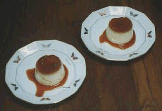
|

| Making Desert with Junko Delicious Home-Made Pudding  - Japanese Recipe - |
Preparation Ingredients Reference Q&A A word from Junko Reader Comment [ last update : 2000.12.02 ] Note: all temperatures given in Celcius |
Preparation
| Preparing the Caramel
  
   You can also make more than you need and freeze for use later on. Preparing the Custard (Ignore the green text if you do not plan on using fresh cream)
Break the eggs into a bowl, and beat with a beater making sure not to let them froth. Bubbles in the mixed eggs will prevent the mixture from being smooth. Once you have beaten the eggs, mix in the granulated sugar (and honey if you prefer.)
Mix the warmed milk into the egg and sugar mixture from Step 4, and add the vanilla essence.  Taste the mixture at this point. A little rum or brandy can add some pizzazz to liven it up a bit.
Strain the mixture. Remove any solidified portions that may have formed on the surface.  (These solidified portions alter the taste if left in.) If you are using fresh cream, strain it before mixing it in. (Cream is even more delicate than milk, so warming it with the milk will make the milk fat separate and ruin the taste.)
Check the temperature of the mixture. When it feels about body temperature, pour it into the mold. If it is not warm enough, warm it up in a bowl placed in warm water (around 40 to 50 degrees).  If you are using fresh cream, the temperature may drop slightly due to the added cream, so warm it before placing it in the oven. Pour into the mold. Remove any solidified portions on the surface.  Fill the tray on the baking sheet in the oven with hot water and cover the cups with lids. (Move slightly.)    Leave in the oven at 150 degrees for 37 minutes. If it does not come out well, try again at between 150 and 160 degrees for 35 to 40 minutes.
Take the cups out of the oven. Shake the pudding a bit. If it does not seem hard enough yet, put back in the oven for 2 to 3 minutes. If it is only a bit liquidy, then the left over heat from the oven will be enough to harden it. Let cool, place in the refrigerator, and you are done!  Other Possibilities Add other flavorings to the milk in Step 1 to make coconut pudding, tea pudding, or anything else your fancy desires. Solid foods like mango or sweet potato should be mixed into the milk using a blender. Your imagination is the limit! |
Ingredients
For standard pudding
| Milk | 500 ml | ¥114 | 295 kcal |
| Yolks | 2 | ¥137 | 560 kcal |
| Eggs | 5 | ||
| Granulated sugar (for the custard) |
90 g | ¥28 | 348 kcal |
| Granulated sugar (for the caramel) |
50 g | ||
| Total | ¥280 | 1397 kcal | |
| Per serving | ¥28 | 140 kcal | |
pudding with fresh cream and honey
| Milk | 500 ml | ¥114 | 295 kcal |
| Fresh cream | 100 ml | ¥149 | 443 kcal |
| Yolks | 4 | ¥119 | 480 kcal |
| Eggs | 2 | ||
| Honey | 20 g | ¥40 | 59 kcal |
| Granulated sugar (for the custard) |
70 g | ¥24 | 271 kcal |
| Granulated sugar (for the caramel) |
50 g | ||
| Total | ¥445 | 1741 kcal | |
| Per serving | ¥45 | 174 kcal | |
Supplement
| Sweetness First, we should talk a little bit about the difference between granulated sugar and white superior soft sugar. Granulated sugar has a refined, light flavor, while white superior soft sugar brings out a thicker, richer sweetness. When you need a richer flavor for butter cakes or sponge cakes, white superior soft sugar is your man. However, granulated sugar is what you need to get that delicate, refined taste for puddings or mousses. The honey used in this recipe is for adding flavor by bringing out a unique aroma and flavor, changing the taste a bit. Fresh cream Eggs |
Reference
| Pudding Cup You can get a package of 10 pudding cups for around ¥160 (100cc cups). This is just the right size. Calories by Ingredient
|
|||||||||||||||||||||||||||||||||||||||||||||||||||||
Q & A
| Question: What is the most important thing
to remember? The oven temperature and the baking time. A mere five-minute difference can ruin the pudding. The oven temperature should be set to between 150 and 160 degrees. Baking time should be around 35 minutes. The whole process is very simple, with only three steps: mixing, straining, and then braising. One important point is to make sure not too much air gets in the mixture when mixing. Question: How long does it take to make? Question: What is the secret behind the
ingredients? Question: How are the pores created? Question: How can I avoid such pores?
Question: Why do you add honey? Question: What about the fresh cream? Question: Is it ok to take the finished
pudding out of the oven and put it right into the refrigerator? |
| A word from Chef Junko I have made all sorts of puddings, but the most delicious is the standard custard putting. Pumpkin pudding is good, too, but the flavor depends too much on the pumpkin used. The most important point to keep in mind when making pudding is the oven temperature.This is what it all comes down to. The rest is just mixing. Let me know any suggestions or comments at junko@iina.com. |
| Reader Comment
Mogumogumogu Tan-san |

|
recipe by Junko Nishimura produced by iina pudding world |

